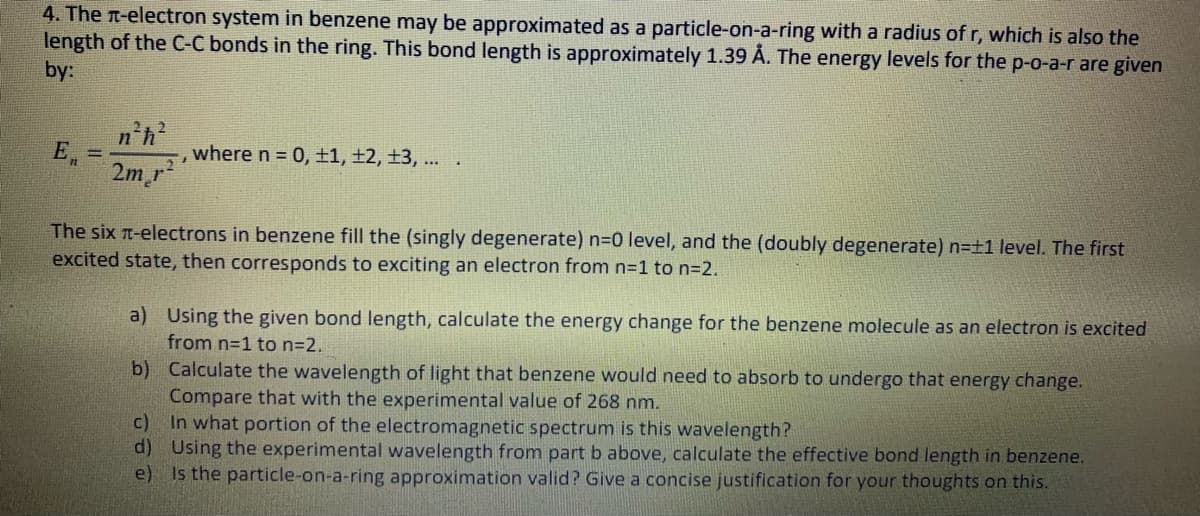4. The t-electron system in benzene may be approximated as a particle-on-a-ring with a radius of r, which is also the length of the C-C bonds in the ring. This bond length is approximately 1.39 Á. The energy levels for the p-0-a-r are given by: n'h? E, where n = 0, ±1, ±2, ±3, ... %3D 2m r The six t-electrons in benzene fill the (singly degenerate) n30 level, and the (doubly degenerate) n=±1 level. The first excited state, then corresponds to exciting an electron from n-1 to n=2. a) Using the given bond length, calculate the energy change for the benzene molecule as an electron is excited from n=1 to n=2. b) Calculate the wavelength of light that benzene would need to absorb to undergo that energy change. Compare that with the experimental value of 268 nm. c) In what portion of the electromagnetic spectrum is this wavelength? d) Using the experimental wavelength from part b above, calculate the effective bond length in benzene. e) Is the particle-on-a-ring approximation valid? Give a concise justification for your thoughts on this.
4. The t-electron system in benzene may be approximated as a particle-on-a-ring with a radius of r, which is also the length of the C-C bonds in the ring. This bond length is approximately 1.39 Á. The energy levels for the p-0-a-r are given by: n'h? E, where n = 0, ±1, ±2, ±3, ... %3D 2m r The six t-electrons in benzene fill the (singly degenerate) n30 level, and the (doubly degenerate) n=±1 level. The first excited state, then corresponds to exciting an electron from n-1 to n=2. a) Using the given bond length, calculate the energy change for the benzene molecule as an electron is excited from n=1 to n=2. b) Calculate the wavelength of light that benzene would need to absorb to undergo that energy change. Compare that with the experimental value of 268 nm. c) In what portion of the electromagnetic spectrum is this wavelength? d) Using the experimental wavelength from part b above, calculate the effective bond length in benzene. e) Is the particle-on-a-ring approximation valid? Give a concise justification for your thoughts on this.
Principles of Modern Chemistry
8th Edition
ISBN:9781305079113
Author:David W. Oxtoby, H. Pat Gillis, Laurie J. Butler
Publisher:David W. Oxtoby, H. Pat Gillis, Laurie J. Butler
Chapter4: Introduction To Quantum Mechanics
Section: Chapter Questions
Problem 39P: Chapter 3 introduced the concept of a double bond between carbon atoms, represented by C=C , with a...
Related questions
Question

Transcribed Image Text:4. The n-electron system in benzene may be approximated as a particle-on-a-ring with a radius of r, which is also the
length of the C-C bonds in the ring. This bond length is approximately 1.39 Å. The energy levels for the p-o-a-r are given
by:
n'h
E, =
where n = 0, ±1, ±2, ±3, ..
2m r
The six t-electrons in benzene fill the (singly degenerate) n30 level, and the (doubly degenerate) n=±1 level. The first
excited state, then corresponds to exciting an electron from n=1 to n=2.
a) Using the given bond length, calculate the energy change for the benzene molecule as an electron is excited
from n=1 to n=2.
b) Calculate the wavelength of light that benzene would need to absorb to undergo that energy change.
Compare that with the experimental value of 268 nm.
c)
In what portion of the electromagnetic spectrum is this wavelength?
d) Using the experimental wavelength from part b above, calculate the effective bond length in benzene.
e) Is the particle-on-a-ring approximation valid? Give a concise justification for your thoughts on this.
Expert Solution
This question has been solved!
Explore an expertly crafted, step-by-step solution for a thorough understanding of key concepts.
This is a popular solution!
Trending now
This is a popular solution!
Step by step
Solved in 3 steps

Knowledge Booster
Learn more about
Need a deep-dive on the concept behind this application? Look no further. Learn more about this topic, chemistry and related others by exploring similar questions and additional content below.Recommended textbooks for you

Principles of Modern Chemistry
Chemistry
ISBN:
9781305079113
Author:
David W. Oxtoby, H. Pat Gillis, Laurie J. Butler
Publisher:
Cengage Learning

Introductory Chemistry: A Foundation
Chemistry
ISBN:
9781337399425
Author:
Steven S. Zumdahl, Donald J. DeCoste
Publisher:
Cengage Learning

Physical Chemistry
Chemistry
ISBN:
9781133958437
Author:
Ball, David W. (david Warren), BAER, Tomas
Publisher:
Wadsworth Cengage Learning,

Principles of Modern Chemistry
Chemistry
ISBN:
9781305079113
Author:
David W. Oxtoby, H. Pat Gillis, Laurie J. Butler
Publisher:
Cengage Learning

Introductory Chemistry: A Foundation
Chemistry
ISBN:
9781337399425
Author:
Steven S. Zumdahl, Donald J. DeCoste
Publisher:
Cengage Learning

Physical Chemistry
Chemistry
ISBN:
9781133958437
Author:
Ball, David W. (david Warren), BAER, Tomas
Publisher:
Wadsworth Cengage Learning,